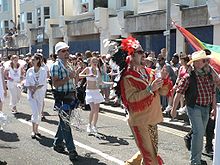LGBT culture in Brighton and Hove: Difference between revisions
clean-up, references and restoring some material |
corrected figure from source |
||
| Line 2: | Line 2: | ||
The following are resources and events serving the [[lesbian]], [[gay]], [[Bisexuality|bisexual]] and [[transgender]] (LGBT) community in the [[United Kingdom|British]] [[city status in the United Kingdom|city]] of [[Brighton and Hove]]. |
The following are resources and events serving the [[lesbian]], [[gay]], [[Bisexuality|bisexual]] and [[transgender]] (LGBT) community in the [[United Kingdom|British]] [[city status in the United Kingdom|city]] of [[Brighton and Hove]]. |
||
Brighton is well known for having a very substantial LGBT community, effectively making it the UK's 'gay capital' (much as San Francisco can be considered the same in the [[USA]]). The 2001 [[census]] revealed that Brighton and Hove had the highest proportion of same-sex households in the country at 1.29%: some |
Brighton is well known for having a very substantial LGBT community, effectively making it the UK's 'gay capital' (much as San Francisco can be considered the same in the [[USA]]). The 2001 [[census]] revealed that Brighton and Hove had the highest proportion of same-sex households in the country at 1.29%: some 2,544 individuals said that they lived with a person of the same sex.<ref>{{citeweb|url=http://news.bbc.co.uk/1/hi/england/3456635.stm|title=Brighton 'has most gay couples'|publisher=[[BBC News]]|date=2004-02-03|accessdate=2009-08-30}}</ref> |
||
==Events and organizations== |
==Events and organizations== |
||
Revision as of 20:12, 7 September 2009

The following are resources and events serving the lesbian, gay, bisexual and transgender (LGBT) community in the British city of Brighton and Hove.
Brighton is well known for having a very substantial LGBT community, effectively making it the UK's 'gay capital' (much as San Francisco can be considered the same in the USA). The 2001 census revealed that Brighton and Hove had the highest proportion of same-sex households in the country at 1.29%: some 2,544 individuals said that they lived with a person of the same sex.[1]
Events and organizations
Brighton Pride is an event, and wider organisation, which promotes equality and diversity, and advances education to eliminate discrimination against the Lesbian, Gay, Bisexual and Transgender (LGBT) community. The major event is an annual summer festival held in the first week of August.[2] The 2005 summer event attracted 120,000 visitors.[3]
The Brighton & Hove LGBT Switchboard is a telephone helpline that describes itself as 'providing a service to the lesbian, gay, bisexual & trans communities since April 1975' and is one of the oldest in the UK.
Also based in Brighton is the UK charity the Gender Trust set up in 1990 that aims to help transgender people with gender identity issues. The Clare Project is a local support group which provides a safe and confidential meeting place for anyone exploring issues around their gender identity, besides organising other events such as monthly meals and a regular Sunday Social.
The city also has the Allsorts Youth Project, which recently passed a unanimous resolution to include transgender young people and those who are unsure as members of Allsorts at their Annual General Meeting on the 21st November "to support young people who are lesbian, gay, bisexual, trans or unsure (LGBTU) of their sexuality".
Both Brighton and Sussex universities have their own LGBT organisations, sometimes working together, to cater to the needs of the ever increasing number of LGBT students. Widely regarded as one of the best LGBT groups in the country, LGBrighTon is for Brighton University students and The Sussex Uni LGBT has members from Sussex University.
The Brighton Our Story Project was set up to collect and preserve our lesbian and gay history community in the area.[4]
In 2000 the award-winning and large scale LGBT community survey, Count Me In, led to the development of an LGBT Community Strategy 2001-06 for Brighton & Hove. Spectrum developed from this process to work with local services and planners in implementing the strategy, and to provide infrastructure and community development support for the LGBT community. Its aim is to act as an independent voice, negotiating the rights of LGBT people locally with specific focus on the needs of marginalised sections of the LGBT community. A second study, Count Me In Too!, published its 'Initial findings Reports' in June 2007, in partnership between the University of Brighton and Spectrum. The second study aimed to identify gaps in the original research and update the strategy.
Two free magazines are distributed in the city: Gscene, which describes itself as 'the gay and lesbian lifestyle, listings and community magazine for Brighton and Hove', and 3sixty, that describes itself as 'your online guide to gay life round the south.' Brighton also has a gay and lesbian sports society called BLAGSS which offers a range of 17 sports or activities to its 600+ members, and a branch of the Metropolitan Community Church.
Historical stories
An early recording of of the LGBT community in Brighton was in August 1822, when George Wilson, a servant from Newcastle-upon-Tyne, was accused by a guardsman he had met in the Duke of Wellington public house in Pool Valley of having offered him a sovereign and two shillings to go with him onto the beach to "commit an unnatural crime".[5]
Another early story of the LGBT community in the area is that of philanthropist Angela Burdett-Coutts (1814-1906), a friend of both Charles Dickens and the Duke of Wellington, who spent part of each year at the Royal Albion Hotel with her companion Hannah. The couple were devoted to each other, socially recognized as a pair, and even sent joint Christmas cards. When Hannah died in 1878, Baroness Burdett-Coutts said she was utterly crushed by the loss of "my poor darling, the companion and sunshine of my life for 52 years".[5]
References and notes
- ^ "Brighton 'has most gay couples'". BBC News. 2004-02-03. Retrieved 2009-08-30.
- ^ "All About Pride".
- ^ "Brighton Pride homepage".
- ^ "Brighton Our Story homepage".
- ^ a b "Brighton's story". Brighton Ourstory. Retrieved 2009-08-30.
